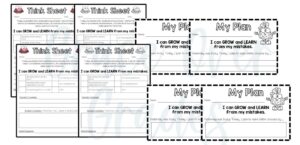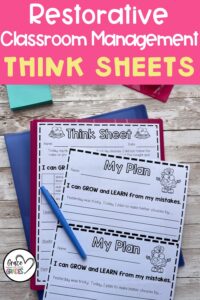
Keys to using Restorative Practices in Your Classroom
I’ve been teaching for 18 years, so when it comes to behavior management in classrooms, I’ve seen it all! The good, the bad and the ugly. If I’m being honest, I’ve probably TRIED it all. Use restorative practices in my classroom changed everything for my classroom community!
I hate that it took me so many years to find a truly effective elementary behavior management system. I’m hoping that by sharing what I’ve learned about restorative practices, it will save you the time and tears that I spent figuring it all out!
This post will provide an outline of how to incorporate restorative practices in your classroom and the potential benefits for both students and teachers.
When thinking about behavior management in classrooms, How is Restorative Practices different from Traditional Disciplinary Practices?
Traditional disciplinary practices focus mostly on giving a consequence for negative behaviors.
Restorative practices focus on repairing and improving the relationship bonds often broken when there are difficult behaviors in classrooms. These relationships could be teacher-student or student-student bonds. Logical consequences CAN often go along with restorative practices.
Benefits of Using Restorative Practices in the Classroom:
Behavior management in classrooms should not only decrease student misbehavior but also improve classroom community & environment. Restorative practices does those things and so much more! Check out this list – and YES I’ve seen many of these at work in my classroom.
- Decrease in student misbehaviors
- Better understanding of logical consequences for actions
- Increase in students’ self-confidence
- Improved teacher-student relationships with mutual trust and respect
- Improved peer relationships with mutual trust and respect
- Increase in student responsibility
- Improved communication skills
- Teaches the importance of empathy & forgiveness
- Gives opportunities to handle conflict with respect and self-control
- Fosters a growth mindset when tackling problems
Ways to Implement Restorative Practices in Your Classroom
- Classroom Expectations & Norms – When planning behavior management in classrooms, it’s important to spend adequate time at the beginning of the school year co-creating classroom expectations and rules. This makes the students part of the process. It also makes your classroom norms clear from the beginning.
- Share Classroom Consequences – A natural follow-up to creating classroom rules and is sharing what will follow if rules are broken. In my classroom, the consequences are tiered:
- a conversation to problem solve with me
- a conversation to problem solve with parents at home
- meeting with the principal to problem solve during a preferred activity time


Think Sheets are a valuable tool I use after students have already been given warnings for an undesired behavior. Think Sheets really helps walk the students and families through this problem solving process. Let me explain how I use them:
- The student and I sit down. As I’m completing my portion of the page, I explain what I’m writing. We discuss what the student did and I challenge them to reflect on the “why” behind their behavior. Were they seeking peer attention? Were they having hard time focusing? Did they feel a big emotion? Etc
At this point, it’s also important to point out that we learn from our mistakes. No one is defined by one mistake they make. This is an opportunity to make a plan for the next day so they don’t repeat the same behaviors.




- The student takes the sheet home and completes the remainder with their family. I encourage the families to have a discussion about what happened and make a plan for the next day.
- The next morning, the student bring their signed family page and completes the “My Plan” page (and a “My Apology” page if necessary.) Then, you have a BRIEF meeting so they can share the plan with you. I like to end with a high-five and words of encouragement.
When thinking about possible systems for behavior management in classrooms, restorative practices is a clear winner. It has proven to be an effective way to build relationships and foster an environment of respect and understanding. What more could a teacher ask for?!
You can get your copy of the Think Sheets HERE.
Did you know you can get access to this along with EVERY other resources Grace Over Grades have ever made? Just join our Membership to enjoy UNLIMITED downloads!
Don’t forget to pin this post for other teachers!


If you found this post helpful, you might also like to read about using CALM DOWN CORNERS or MINDSET QUOTES AT MORNING MEETING.

